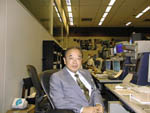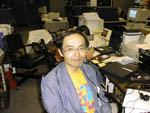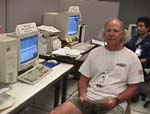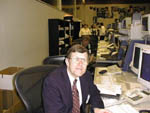|
|||||
 |
 |
|
|
 T.
Mano T.
ManoCo-Investigator of the experiment "Autonomic Neuroplasticity in Weightlessness" I'm very pleased to have this opportunity to take part in this international collaborative research, focused on the effects of weightlessness on the human autonomic nervous system. In this Neurolab program, we will record astronaut's autonomic nervous function data, including muscle sympathetic nerve activity that controls blood pressure, by means of microneurography, a technique to measure electrical signals from human peripheral nerves using a tungsten microelectrode, before flight, during mission and after landing. We look forwards to the results of this experiment. What we will learn should be useful in obtaining new knowledge about the mechanism and treatments of blood pressure disorders. (April 26, 1998) Message of the successful experiment One of the researches concerning the autonomic nervous system for Neurolab is to analyze human sympathetic nerve activity using microneurography. This research project has been prepared by an international co-operation of 4 Principal Investigators (Prof. G. Blomqvist, Prof. D. L. Eckberg, Prof. D. Robertson from U.S.A. and Dr. F. Baisch from Garmany) and Co-Investigators from U.S.A., Germany and Japan. Microneurography is a technique to measure electrical signals using a thin electrode with a tip diameter of about 1-micrometer inserted into human nerves. This technique needs much training. Alternative Payload Specialist Dr. Chiaki Mukai Astronaut of Japan has mastered this technique. The aim of micronuerography research in space is to elucidate how the changes in autonomic nervous functions are concerned with the mechanisms underlying cardiovascular deconditioning, particularly blood pressure dysregulation related to spaceflight. For this aim, microneurography recordings from astronauts were scheduled on the earth before flight, on 12th and 13th days during flight, and after landing. But we have been wondering if microneurography recording is really possible in space, because this technique is very difficult even on the earth and various noise sources are suspected in Space Shuttle. On April 28, two payload specialists, Dr. J. Pawelczyk and Dr. J. Buckey during flight in Space Shuttle Colombia served as examiner and also as subject. Muscle sympathetic nerve activity, which is important for blood pressure control, was recorded from the peroneal nerve of the right leg to measure the basal level and the responses to various stimuli. The first trial of microneurographic recording of human sympathetic nerve activity in space was very successful without contamination of noise. It is difficult to mention about the results before the data analysis, but we had an impression that the basal level of muscle sympathetic nerve activity was well preserved under microgravity in space. The sympathetic nerve responses to Valsalva test ( a kind of breath holding), hand gripping, cold pressor test, lower body negative pressure seemed also to be relatively well maintained. Anyhow the success of miceoneurographic recording of muscle sympathetic nerve activity from astronauts in space is epoch making. The findings obtained from this research may be useful to understand the mechanisms and to establish effective countermeasures of cardiovascular deconditioning related to spaceflight. (April 29, 1998) |
 Dr.
Iwase, Nagoya University Dr.
Iwase, Nagoya UniversityCo-Investigator of the experiment "Autonomic Neuroplasticity in Weightlessness" Dr. Iwase talks about the Autonomic Neuroplasiticity in Weightlessness experiment. Our blood pressure is unconsiously controlled by our autonomic nerve no matter if we are standing or laying down. The autonomic nerve has two types of activities, the sympathetic nerve acitvity and the subsympathetic nerve activity. In this experiment, we insert a microelectrode as fine as hair into the astronauts' nerve fascicle, and record the activities of the autonomic nerve. (April 23, 1998) |
 I.
Koizuka I.
KoizukaCo-Investigator of the experiment "Spatial Orientation of the Vestibulo-Ocular Reflex" The inner ear is consisted of the semicircualar canals and the otolith organs. The semicircualar canals sense the angular acceleration and the otolith organs sense the linear acceleration. On the earth to maintain our balance, we use each information from both sensores. Whereas in the space, because of the lack of the gravity, otolith input to the center for spatial orientation disappeared. In the Neurolab, we investigate the change of the otolith function using eye movement. Several investigations regarding human balance system were performed. But the Neurolab is very unique in this regard that the computer-controled roational chair is equipped in the space shuttle Columbia to investigate otolith function. We hope that exiting and precise results in the human balance system will be obtained. (April 20, 1998) Report from Dr. Izumi Koizuka, Co-Investigator of "Spatial Orientation of the Vestibulo-Ocular Reflex" The key to the sucess of our experiment is to obtain a clear and focused picture of the eyeball. Needless to say, the astronaut has to keep thier eyes open despite of the movement of the rotating chair. Judging from the pictures send down to us so far, all of them are perfect. We are very happy with these results which are essential to the sucess of the experiment. Our initial plans were to use the video taken aboard the shuttle which would be handed over to us after the landing for analysis, but since the downlinked images are in such good condition, we have already started part of the analysis using these data. We might be able to find the results of our studies sooner than we had expected. On the day before landing, we are going to conduct the last run of our experiment. After landing, we will conduct the same experiment several times to see how humans re-adapt the Earth environment. Everyone in our team is very excited to see the results of these experiments too.(May 1, 1998) |
 S.M.
Highstein S.M.
HighsteinPrincipal Investigator of the experiment "Chronic Recording of Otolith Nerves in Microgravity" P.I. is pleased that we have recorded neural data and accelerations from all 4 F.P.s intermittently. There have been multiple periods of recording from each FP with the longest being 2 hours continuous. Additionally the wafer electrode in FP1 appears to be functioning well as we have collected neural data from both channels including responses to manual acceleration. PI feels that we should accomplish 100% of the science goals of the mission.@(April 19, 1998) |
 D.L.
Eckberg D.L.
EckbergPrincipal Investigator of the experiment "Autonomic Neuroplasticity in Weightlessness" The Autonomic Nervous System Team is thrilled to be participating in the landmark Neurolab Space Shuttle Mission. Our protocol may represent the most complicated human biomedical research ever undertaken in space. We value the contributions of our esteemed Japanese colleagues in this international effort, which we hope will be extraordinarily successful. (April 7, 1998) |
Last Updated : April 28, 1998

|